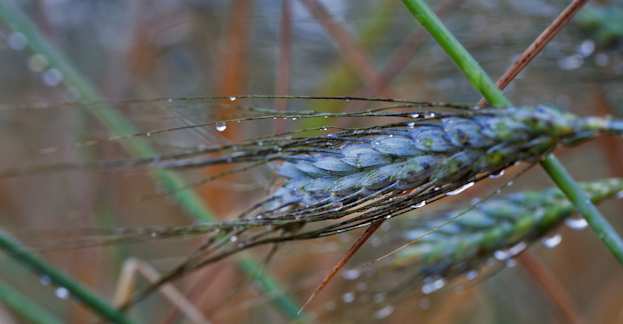What You Need to Know About Farro

Farro is Italian. Specifically, farro is the Italian word for ancient grains brought by denizens of the Fertile Crescent to the region that is now Italy. The cradle of civilization and birthplace of wheat, the Fertile Crescent is an arc of territory beginning in northeastern Africa and ascending up through lands bordering the eastern Mediterranean rim, then swinging up and over to the east, and then down to the Persian Gulf. Think war: the region has been at war in some form for millennia, a curious backdrop for an occupation as peaceful as farming innovation and world-class seedsmanship.
Like many transcultural foodstuffs, farro abounds with confusing names and a trove of great stories, some of which contradict, some of which move farro foodways forward. Farro dates to the inception of domesticated plants and the advent of dedicated farming. We can be proud of farro because Roman legions charged relentlessly across conquered lands at inhuman speed sustained by its nourishment. And we excuse the recent scrambling of farro classification because, really, it’s amazing food no matter what it’s called.
Simple whole-berry farro has three identities in Italy alone, and each dates back to antiquity: farro piccolo (little farro), farro medio (medium farro), and farro grande (big farro). So what’s the problem with this?
In the 20th century, the Germans, master grain growers and millers since antiquity, chose to call farro piccolo einkorn—a succinctly German downbeat of a name that refers to an individual awn’s tendency to break into single spikes: ein korn or “one kernel.” More poetically, the French call farro piccolo le petit épeautre. In Hebrew, the name for farro medio is emmer, or “mother.” (We like this one, because Native Americans call corn “mother.”) When it comes to farro grande, the Germans call it dinkel, though we note no special reason in that. In English, farro grande is spelt. Farro medio is emmer just as it is in Hebrew. Farro piccolo is probably einkorn, but einkorn can come from anywhere, and farro piccolo comes only from Italy. There, that was easy.
Latin for each farro classification (pay attention—there will be a test later) is more precise: farro piccolo is Triticum monococcum, farro medio is Triticum dicoccum, and farro grande is Triticum spelta. Farro should be classified small, medium, or large, and it should be that simple. But those sneaky Italians have farro piccolos that are larger than farro medios, and farro medios and farro grandes that are smaller than farro piccolos. So, as often happens when you stray from Latin names, everything gets all mixed up.
Forget the test. The Italians and the French of Provence romance farro dishes, and one comes to fall in love with their unending and luxurious culinary takes on this grain. Germans quote health proverbs and boast that their farro cookery is better than that of the French. Here in America, we watched farro become a trend almost two decades ago. It’s hard to believe chefs use to fight over supply. Farro was allocated in Italy and in America like rare wine. But American chefs have brought thrills to farro’s flavor and texture envelope in the last few years, and now there are candied farro puffs floating around out there in pastry chef land. Curious, but sublime when paired with airy popcorn mousse.
More than a decade ago, Anson Mills began growing dozens of different cultivars of farro piccolo, farro medio, and farro grande. We knew they were farro, not einkorn or emmer, because they came from Italy and spoke Italian, not German or Hebrew. We did this because the first Charlestowne rice farmers were Italian, and it was these Italian rice farmers who brought farro—tough, persistent, and barely removed from its wild counterpart—to Charlestowne for winter cover cropping in the new rice fields. They winter-grazed and occasionally early spring–grazed their cattle over the farro before harvesting the grain and moving on to the next crop in late spring.
What really hooked us on farros piccolo, medio, and grande was the stunning spectrum of their whole-berry Italian heritage cookery. We were particularly interested in slow-roasted farro, and rice and farro cooked together in the same pot as pilaf, and farro cooked to its risotto clone (and known as farrotto). Beyond these forms, the plain berries overtake your senses when simmered in a little water and finished with shaved sea salt and a splash of young estate olive oil. If you cook farro this way, you will be devoted for life. What draws you in is the primordial “grain” aroma and flavor, the al dente cushionlike resistance of each berry, and the miniscule but distinct pop of each grain, as well as the burst of caramel across the palate, followed by deep mineral and field grain richness. This is how the oldest domesticated grain food on our planet drills into your consciousness.
We learned from farro that you can teach an old grain new tricks. Farro can be ground and simmered like corn to make polenta di farro, it can take the place of rice in rice pilaf, or it can replace Arborio rice and cooked into farrotto. The oldest grains adapt to diverse foundation recipes with blinding versatility, as if they have always been a part of the preparation. Farro culinary culture also taught all of us at Anson Mills the global nature of cereal foodways. We hope you have this epiphany as well.